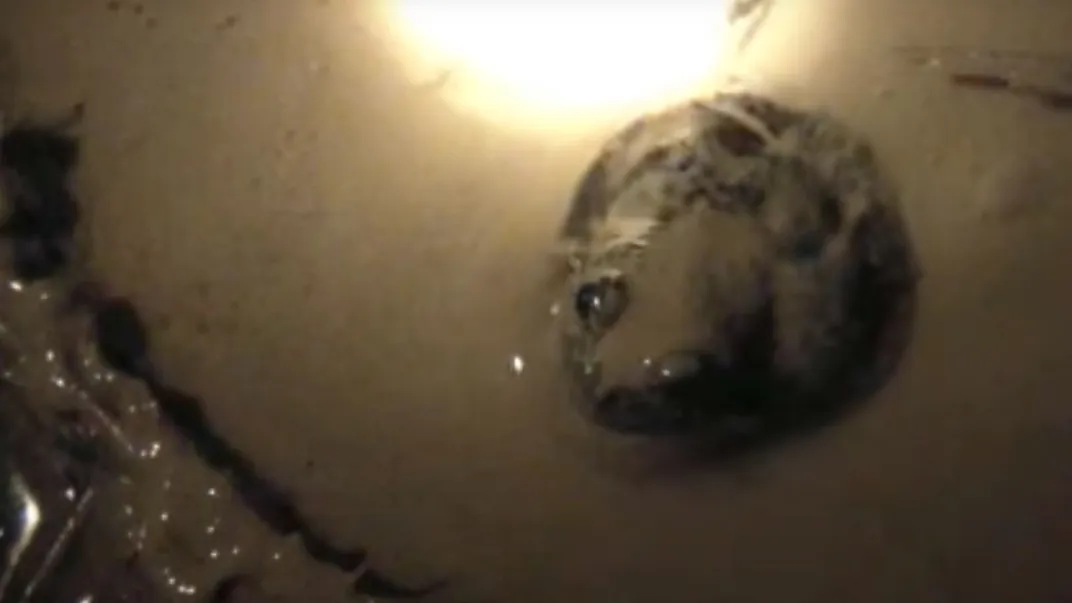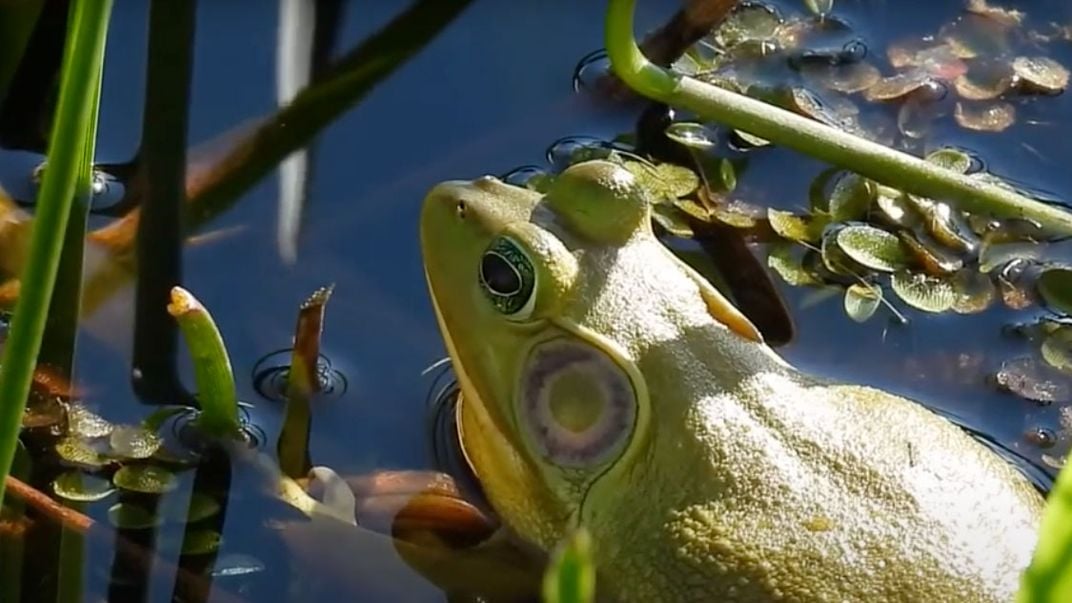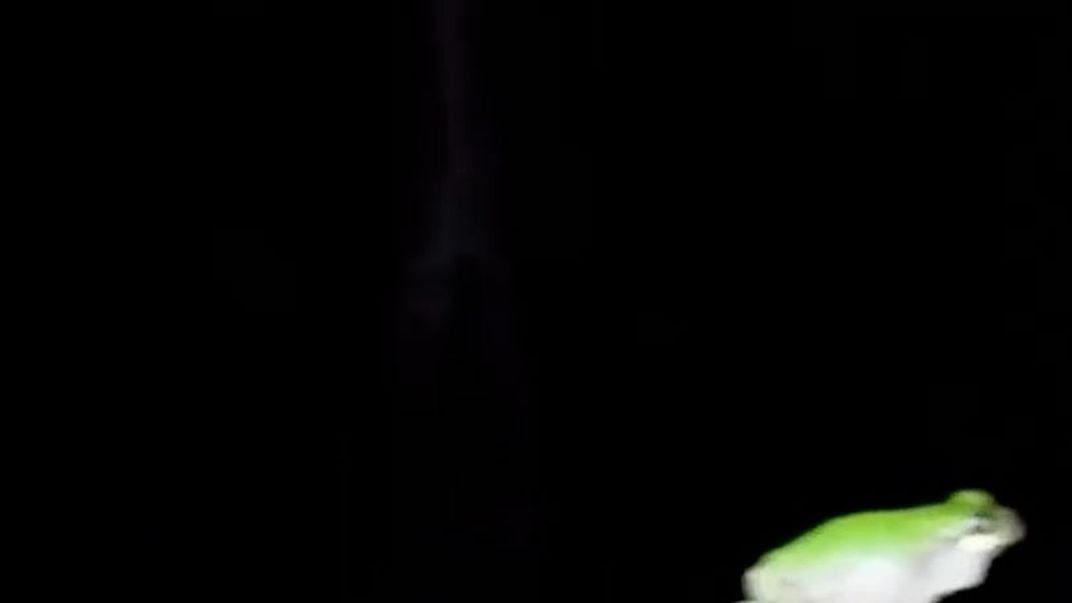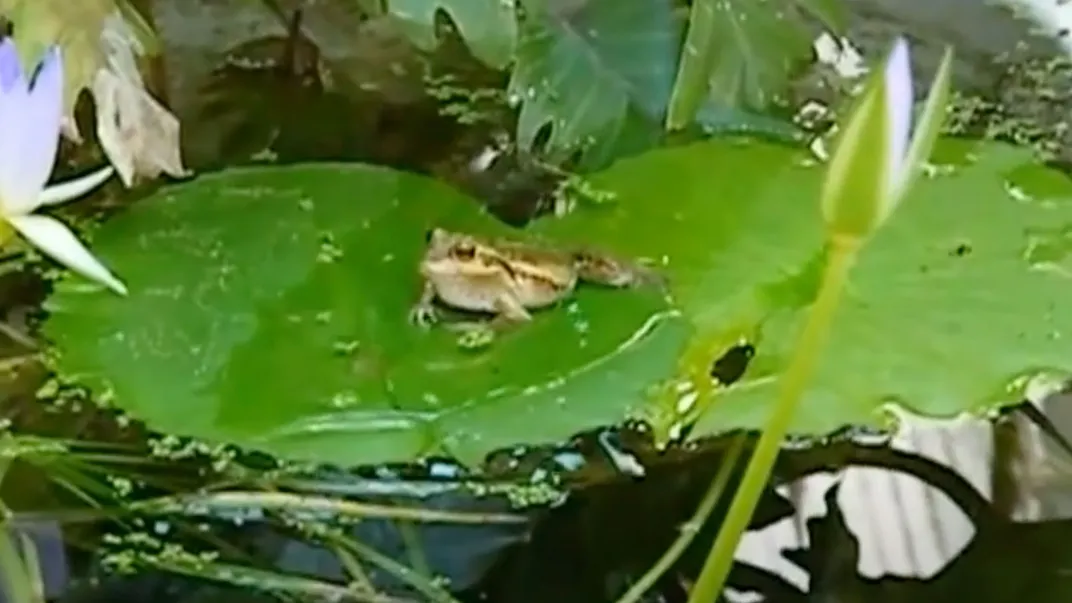More than 7,000 species of frogs hop, climb and perch around our world—which means more than 7,000 unique frog calls permeate our air.
“The diversity of frog sounds is hard to overstate,” says Mark Scherz, a herpetologist at the Natural History Museum of Denmark. “They come in all manner of sounds, from ones that sound like dogs barking, to fire alarms, to whistles and pops and cracks.”
Frogs call by passing air over their vocal cords, like humans, and can amplify the sound with a vocal sac that makes sound resonate. Frogs mostly call to attract mates, but they can also make sounds to warn others about their territory, or to express distress or fear.
So why do frogs sound so different from each other? They might be adapting to different environments, to ensure sound transmits the best in their specific surroundings. Since so much frog calling is in the context of communicating with potential mates, which types of calls female frogs prefer can change how male frogs call over time. Many frogs also have different types of vocal sacs, which come in lots of shapes, sizes and colors, and can amplify frog calls in different ways.
We called up herpetologists and searched through scientific studies to find some of the most interesting frog calls in nature. Read on and listen to the collected audio clips to get a sense of just how amazing frogs are.
Bright-eyed frogs (Boophis spp.) can sound like sci-fi technology
Seven new species recently identified in Madagascar, all belonging to the Boophis genus, make whistling sounds that reminded researchers of the sci-fi series “Star Trek.” So they named the species after characters from “Star Trek”: Kirk, Picard, Sisko, Janeway, Archer, Burnham and Pike.
These frogs were thought for decades to all be one species called Boophis marojezensis, since they look almost identical, says Scherz, one of the authors of the October paper. But analyzing their calls helped the research team identify seven different species with unique vocal patterns—in addition to B. marojezensis.
The researchers compared the sounds to the boatswain whistle and the tricorder device from Star Trek. The frogs make these noises as “advertisement calls”: for a male frog to convey information about his availability and suitability as a mate to female frogs.
These frogs live along fast-flowing streams in mountainous areas of Madagascar, and with such loud background noise, their calls may be especially high-pitched to be heard by other frogs over the sound of the water, according to Scherz.
Desert rain frogs (Breviceps macrops) squeak like dog toys
This species, which has been called the world’s cutest frog, is only found on a narrow strip of desert from South Africa to Namibia. This frog is nocturnal and mostly buries itself in the sand during the day. At night it emerges to collect moisture from the surrounding fog. The desert rain frog has a transparent patch of skin on its stomach, so you can look at its insides. And its squeak is extremely cute.
“They’re small animals, they live in a big dark world, they communicate at night,” says Jessie Tanner, a herpetologist at the University of Tennessee. “Those signals, one of their main functions, is to identify appropriate mates and also to find them in space.”
Green frogs (Lithobates clamitans) and Australian banjo frogs (Limnodynastes spp.) twang like banjo strings
A pobblebonk in Australia Auscape / Universal Images Group via Getty Images/https://tf-cmsv2-smithsonianmag-media.s3.amazonaws.com/filer_public/1f/70/1f70d09b-0e03-4c78-9ec5-803a330e69b8/1_gettyimages-578260220_web.jpg)
Green frogs, also called banjo frogs, have a sharp twang call that has been compared to the plunking sound of a loose banjo string. Green frogs live throughout the eastern United States and, despite their name, can vary in color from mostly green to more brownish and bronze.
A different type of banjo frog also lives in Australia: four species belonging to the genus Limnodynastes, which includes the western banjo frog, giant banjo frog and northern banjo frog. They’re also called “pobblebonks,” referring to the sound they make. People say it sounds like a “bonk,” according to Tanner, who compares it to a little plunking.
Pig frogs (Lithobates grylio) oink like swine
Pig frogs live mostly in swamps throughout the southeastern U.S., the Bahamas and Puerto Rico. They look similar to American bullfrogs, and they’re in the same genus. Pig frogs are nocturnal and are most active during the warmest months of the year.
Pig frogs are named for their low grunting sound, which sounds like a pig’s “oink.” They mostly call to attract female frogs, and they will call with a chorus of 1 to 13 short, loud grunts, which can sometimes combine to sound like a roar.
When male frogs call to mate with female frogs, they’re not just communicating where they are but also conveying information about their suitability as a mate, says Tanner. Male frog calls can tell female frogs about the caller’s species, health, endurance and even genetic compatibility.
Bird-voiced tree frogs (Hyla avivoca) call like avians
Bird-voiced tree frogs are mostly found in the southeastern U.S., especially in states bordering the Mississippi River. They thrive in swamps in temperate forests, and they like to sit in trees slightly above the water’s surface.
Their call sounds birdlike, a series of rapidly repeated high-pitched noises, which some compare to the sound of a pileated woodpecker.
The females of this species tend to prefer longer, higher-pitched calls from potential mates. Male bird-voiced tree frogs use a technique of calling when competing with other males in which each frog slightly alters its calls so their frequencies do not overlap. This way they can integrate with each other’s calls in a chorus, but individual calls can still be differentiated by females that are listening.
Carpenter frogs (Lithobates virgatipes) sound like hammering
A carpenter frog in northern Florida/https://tf-cmsv2-smithsonianmag-media.s3.amazonaws.com/filer_public/4a/53/4a53cafb-29e6-4db5-b745-3ce06428d2d9/2_carpenter_frog_rana_virgatipes_web.jpg)
Carpenter frogs live in coastal plains along the East Coast of the U.S. Males are very territorial and defend their realms from other males by wrestling with each other, and by calling.
These frogs make an explosive “pa-tank” sound, repeated up to ten times, which sounds like a hammer. A chorus of carpenter frogs sounds like a construction crew building a house.
Researchers have identified different calls these male frogs make: They have specific sounds to attract females, for aggressive or territorial communication with other males, and to alert another male the caller has been accidentally grabbed for mating.
Motorbike frogs (Litoria moorei) rev like motorcycles
Motorbike frogs are common in southwestern Australia. This frog got its name from its mating advertisement call, which sounds like a motorcycle changing gears.
“They make this really cool amplitude- and frequency-modulated sound … and it just sounds like a motorcycle accelerating,” says Tanner. “If you’re not familiar with the fauna of Western Australia, you will mistake it for that.”
The loud sound helps the frogs communicate with potential mates, but other animals can also eavesdrop and take advantage of the advertisement. “A lot of predators are paying attention to these calls,” says Ximena Bernal, an ecologist at Purdue University. “Here you have a meal that is saying, ‘Here I am! Here I am!’” But according to Bernal, frogs’ need to attract mates can outweigh their concern for predators.
Sheep frogs (Hypopachus variolosus) bleat like sheep
A sheep frog in Costa Rica/https://tf-cmsv2-smithsonianmag-media.s3.amazonaws.com/filer_public/a1/f8/a1f8e3d6-d57c-43f2-81be-97292e37bbe0/3_hypopachus_variolosus_web.jpg)
Sheep frogs are found throughout Central America and Mexico. They love to burrow, and they mostly eat ants and termites. They have a nasal, penetrating call, which sounds like a sheep bleating.
Although sheep frogs are common and their population is generally considered stable, they are threatened in some regions, primarily by habitat fragmentation and loss due to agriculture and urban expansion.
These kinds of threats to frogs are on the rise, with about 200 frog species going extinct since the 1970s. For this reason, we shouldn’t take the diversity of frog sounds for granted, says Bernal. Amphibians are now the most threatened vertebrate group in the world, with 40 percent of species globally threatened. “Frogs are having a really hard time,” says Bernal. “And we are losing a full orchestra of sounds.”























+ There are no comments
Add yours